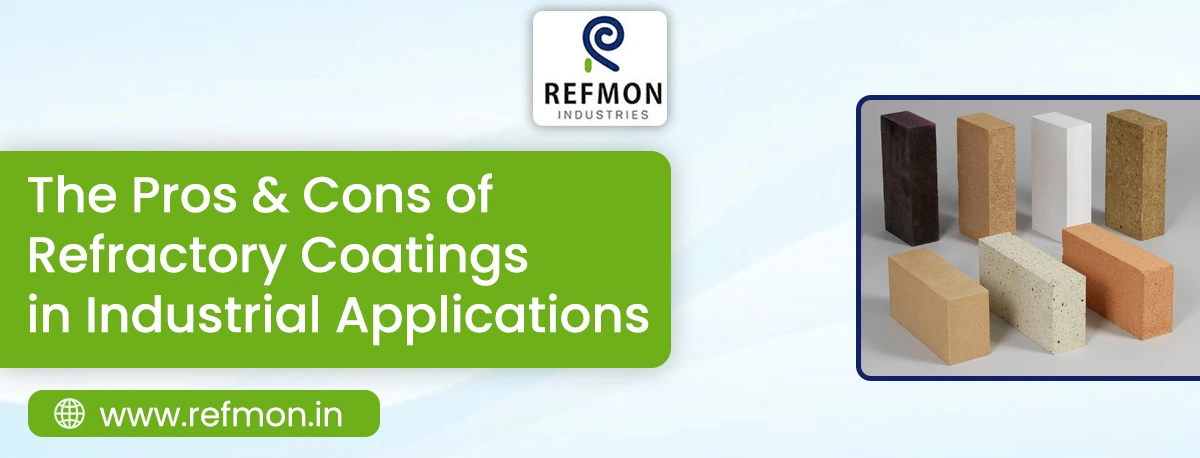
The Pros & Cons of Refractory Coatings in Industrial Applications
Industries engaged in high temperatures, using extreme aggressive chemicals, or resistant materials are more dependent on protection to have their equipment safe and withstand longer life cycles. One way to give protection is through the application of refractory coatings and the use of refractory bricks. Specific coatings act as shields enclosing industrial surfaces and help in their better performance, safety, and life. Examples include furnaces and kilns; however, they have been introduced to boilers and reactors, too. Refractory coatings have now become a critical application in these modernized industries. Like other industrial materials, the rehospitalization also has pros and cons.
What Are Refractory Coatings?
Refractory coatings are materials that modernize and are adapted to withstand lengthy periods under high temperatures, in chemical attacks, or mechanical wear. Usually, they are coat insulators for bricks, steel, or ceramics. These coatings find utility in industries such as steel, cement, glass, petrochemicals, and power, where the equipment is subject to the most severe testing conditions.
A refractory coating protects against heat and energy losses, corrosion, and increases the service life of the industrial system.
Pros of Refractory Coatings
1. High Thermal Resistance: The best-known value of refractory coatings lies in their performance at high temperatures. They are designed to retain both their structure and properties in an environment in which ordinary coatings would otherwise fail, thereby providing great value to furnaces, kilns, and thermal installations.
2. Enhanced Durability: Refractory coatings make sure that equipment remains intact against thermal shocks and mechanical stresses, or damage during constant operation. With this kind of coating, one will increase durability, thereby minimizing repair and maintenance needs, hence cutting down time and costs.
3. Energy Efficiency: Refractory coating saves energy for the industries by improving insulation. Properly applied coatings minimize heat losses and maximize energy transfer to the process instead of being wasted. This is then reflected in savings by way of reduced fuel consumption and lower operating costs.
4. Protection Against Corrosion: Corrosion has always been an ever-recurring phenomenon and continues to pose danger to all those industries working with chemicals and molten materials. The refractory coatings mainly protect equipment against the highly corrosive effects of chemical reactions, oxidation, or acid vapours. This is even more critical in chemical plants and refineries.
5. Versatility of Application: These protective layers may coat all different kinds of surfaces, which include metals, or ceramics. Their versatility thus helps numerous industries to enhance performance without complete system replacement.
6. Longer Equipment Life: Thereby, enhanced thermal resistance with corrosion-resistant property and toughness collectively provide greater life to industrial equipment. Thus, such coatings include the best cost-effective investments for industries operating in extreme conditions.
Cons of Refractory Coatings
1. High Initial Cost: The cost of refractory coatings is one of their major drawbacks. The best coatings and associated application processes may prove to be quite expensive and be considered as a significant capital investment. This may put minor industries or operations with limited budgets in a position where they experience financial setbacks.
2. Application Complexity: If coating is to be applied, the refractory coating is not very easy to use. It demands skilled labour, specialized equipment, and strict adherence to application guidelines. An incorrect application can render a coating useless as an investment fails.
3. Maintenance Requirements: The refractory coatings reduce the frequency of major repairs; they are not maintenance-free to a great extension. They will wear out over time due to the continuous effect of heat and chemicals, and will need periodic inspection and touch-up maintenance for efficacy.
4. Limited Shelf Life of Materials: Unprocessed materials for refractory coatings have a finite shelf life. Improper storage may cause degradation before application, thus incurring more management responsibility for the industries.
5. Downtime During Application: The application or reapplication of refractory coatings will usually involve shutting down the equipment. So, this will affect production schedules, especially continuous operating schedules.
6. Environmental Concerns: Some refractory coatings might derive from particular compounds which are obviously dangerous to the environment or might themselves pose any health or safety hazard during manufacture, application, and/or disposal. Coatings should be selected by industries with available ecology and safety criteria.
Industrial Importance of Refractory Coatings
The refractories manufacturing industry has drastically changed to fulfill the modern-day industrial requirements. The refractories coat has been subjected to innovations from time to time to make it more effective, environment-friendly, and suitable for the requirements of specific industries.
Such companies covering protective solutions, like acid-proof tiles manufacturers Alwar, stress the fact that heavy-duty areas need to combine durability with chemical resistance in their products. An ever-growing demand for safe and energy-efficient operations will keep refractory coatings in business for decades.
Conclusion
Refractory coatings have great importance in industries that involve high temperatures, chemical exposure, and mechanical wear in their daily operations. Their application enhances durability, energy conservation, and equipment protection and is, therefore, attractive in many industries. However, the cost, complexity of application, and maintenance challenges must also be weighed by the industries. If selected properly and applied accurately, refractory coatings will give immense value to various industries.